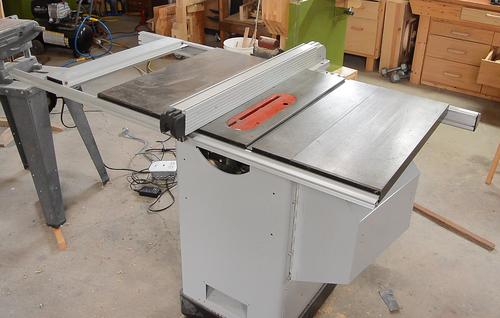
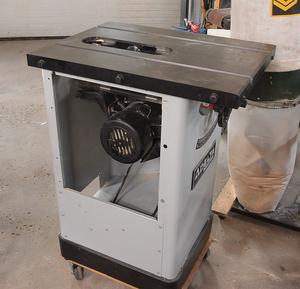 My main table saw is what is known as a hybrid table saw. I get the occasional question
what a "hybrid" table saw is. Does it run on batteries?
My main table saw is what is known as a hybrid table saw. I get the occasional question
what a "hybrid" table saw is. Does it run on batteries?

 My main table saw is what is known as a hybrid table saw. I get the occasional question
what a "hybrid" table saw is. Does it run on batteries?
My main table saw is what is known as a hybrid table saw. I get the occasional question
what a "hybrid" table saw is. Does it run on batteries?
A hybrid table saw is a stationary table saw, built to look like a more expensive cabinet maker saw, with the motor inside, but with internals more like a less expensive "contractor saw". So it's a hybrid between a cabinet maker saw and what was traditionally known as a contractor saw.
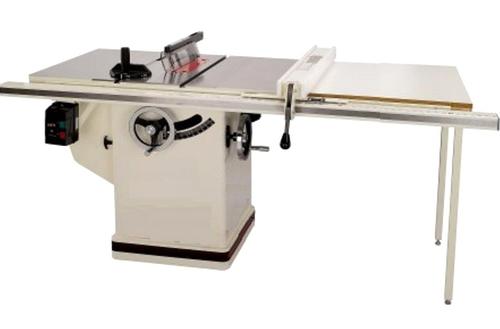
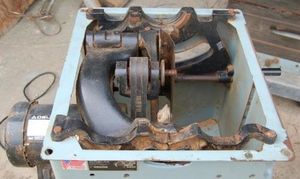 Cabinet maker saws tend to be sturdy and heavy, typically with a 3 hp motor, requiring a 240
volt circuit. The trunnions and saw mechanism are mounted directly onto the cabinet base, whereas
on a hybrid table saw they are usually just bolted to the bottom of the cast iron table.
Cabinet maker saws tend to be sturdy and heavy, typically with a 3 hp motor, requiring a 240
volt circuit. The trunnions and saw mechanism are mounted directly onto the cabinet base, whereas
on a hybrid table saw they are usually just bolted to the bottom of the cast iron table.
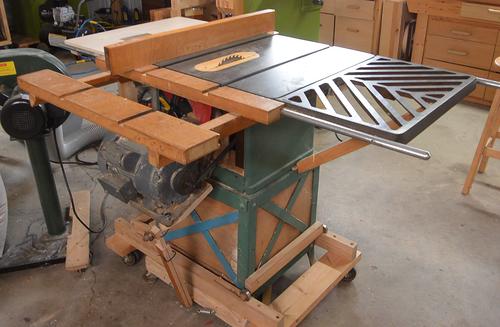
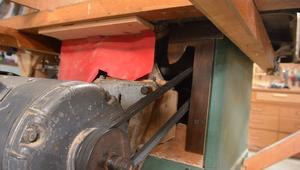 What was traditionally a contractor saw is a saw with a cast iron table, a stand, or legs that
can be detached, a tilt mechanism bolted to the bottom of the table,
and an induction motor hanging out the back.
The heavy motor is easy to remove, and with the motor off such a saw is fairly
luggable by two people.
What was traditionally a contractor saw is a saw with a cast iron table, a stand, or legs that
can be detached, a tilt mechanism bolted to the bottom of the table,
and an induction motor hanging out the back.
The heavy motor is easy to remove, and with the motor off such a saw is fairly
luggable by two people.
At left, my old contractor saw. I added a table extension, replaced the original fence with a wooden one, closed off the base (the base is typically completely open), and added a mobile base. My brother's old contractor saw is more like hoe they come stock.
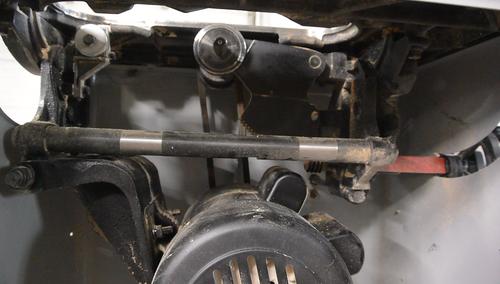 A "Hybrid" table saw is Essentially a contractor saw with a stand
that is fully enclosed, and motor inside
instead of on the back. This makes the saw more convenient in the workshop, but it also
makes it harder to move. But given that most old style contractor saws are stationary
in a hobby workshop these days, this arrangement makes more sense. It doesn't cost any
more to make one of these saws than an old style contractor saw. As such, most manufacturers
no longer make traditional contractor saw type saws, making hybrid table saws instead.
A "Hybrid" table saw is Essentially a contractor saw with a stand
that is fully enclosed, and motor inside
instead of on the back. This makes the saw more convenient in the workshop, but it also
makes it harder to move. But given that most old style contractor saws are stationary
in a hobby workshop these days, this arrangement makes more sense. It doesn't cost any
more to make one of these saws than an old style contractor saw. As such, most manufacturers
no longer make traditional contractor saw type saws, making hybrid table saws instead.
A downside of having the blade tilt raise and lower mechanism and motor hanging off the bottom of the table is that cast the iron table will sag slightly over time. Sagging cast iron sounds hard to believe, but, yes, it happens!
Trunnions bolted to the bottom of the table also makes it much more difficult to adjust the blade alignment (though, ideally that is already set correctly when you buy the saw)
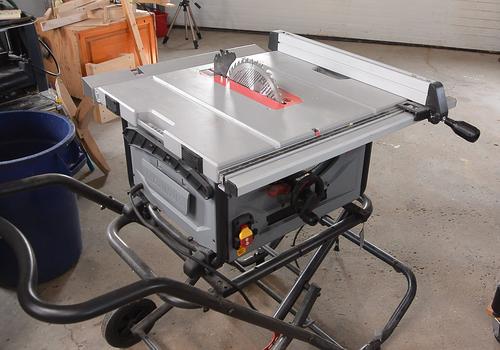 Contractors these days use more portable "jobsite" saws (also referred to as
benchtop table saws), As such, these jobsite saws are now often referred to as
contractor saws.
Contractors these days use more portable "jobsite" saws (also referred to as
benchtop table saws), As such, these jobsite saws are now often referred to as
contractor saws.
Jobsite saws use smaller universal motors, which are much lighter, but also less durable and very loud. The motor is on the inside. Such saws are often used with folding rolling stands like the one at left, which makes the saw very easy to move and be set up by one person. These saws are less solid than cast iron contractor saws, but the increased portability more than makes up for it. The one at left is not a particularly good one. I reviewed it here. You can now even get battery powered jobsite saws
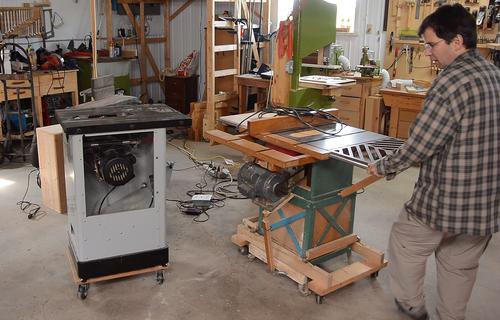 On moving to my new shop, I initially set up my contractor saw, and for a few months, just
used that one until I was sure I wanted to keep this layout. The mobile base on the
contractor saw would have made it easy to move around.
On moving to my new shop, I initially set up my contractor saw, and for a few months, just
used that one until I was sure I wanted to keep this layout. The mobile base on the
contractor saw would have made it easy to move around.
But I was now sure I wanted a table saw in that spot, so it was time to get the hybrid table saw off it's dolly and set it up.
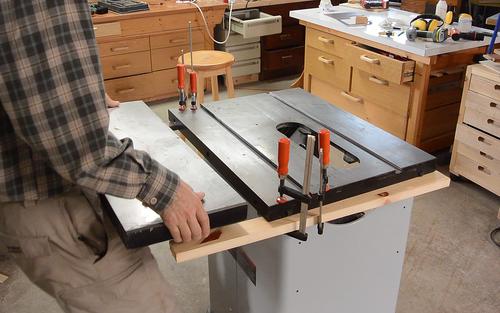 Clamping some pieces of wood to the bottom edge of the table made it easier to position
the cast iron extension tables for bolting them on.
Clamping some pieces of wood to the bottom edge of the table made it easier to position
the cast iron extension tables for bolting them on.
I found the cast iron tables were slightly shorter than the main table, so I made sure the front edges were aligned flush. The front edge needs to be straight to keep the fence perpendicular.
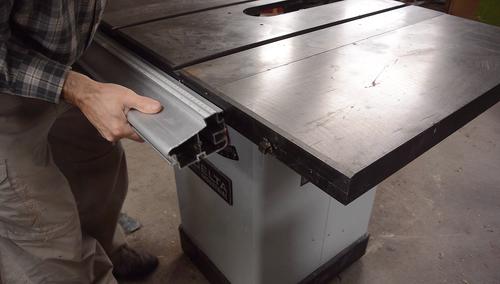
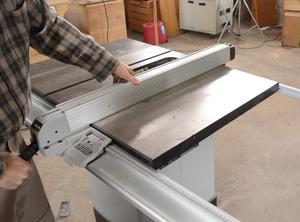 The front fence rail has a T-slot that the bolts going through the front of the table attach to.
The front fence rail has a T-slot that the bolts going through the front of the table attach to.
Another, smaller rail goes on the back, and the fence clamps to both of these rails on this saw.
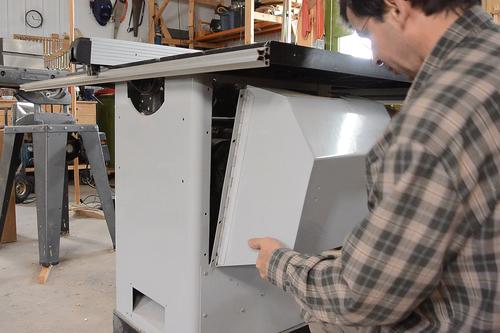 A big bulging door bolts to the left side of the cabinet (my saw is a right-tilt saw).
When the blade tilts to the right, the motor on the bottom tilts to the left, protruding
out of the cabinet. Hence the need for a big bulging door.
A big bulging door bolts to the left side of the cabinet (my saw is a right-tilt saw).
When the blade tilts to the right, the motor on the bottom tilts to the left, protruding
out of the cabinet. Hence the need for a big bulging door.
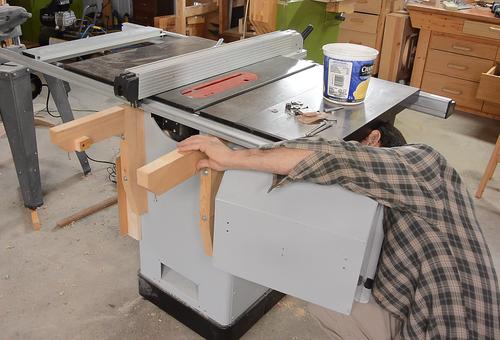 So far I had assembled the saw as it came stock, now adding the L-brackets on the back for a
short outfeed table.
So far I had assembled the saw as it came stock, now adding the L-brackets on the back for a
short outfeed table.
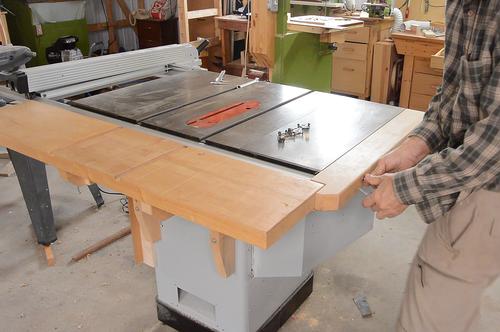 And another extension on the left side of the table. This is very handy when using my big
left-side-only sled.
And another extension on the left side of the table. This is very handy when using my big
left-side-only sled.
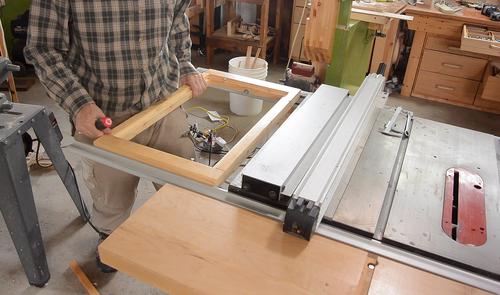 Plus a table extension on the left, which mounts my router lift.
Plus a table extension on the left, which mounts my router lift.
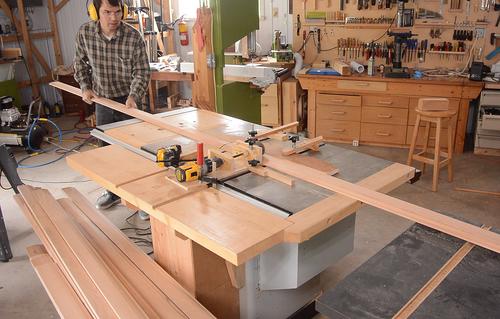 For the most part, a hybrid table saw is used like a cabinetmaker saw, though it's more of a
hobby grade tool. I most recently used this one to
make a whole lot of baseboard molding,
here feeding material through to make some cove cuts. I had over 100 m (300 feet) of molding
to make, so this was hitting the saw hard. If I had to do that often, I'd get a cabinetmaker's
saw. But as it is, the saw stood up to it adequately.
For the most part, a hybrid table saw is used like a cabinetmaker saw, though it's more of a
hobby grade tool. I most recently used this one to
make a whole lot of baseboard molding,
here feeding material through to make some cove cuts. I had over 100 m (300 feet) of molding
to make, so this was hitting the saw hard. If I had to do that often, I'd get a cabinetmaker's
saw. But as it is, the saw stood up to it adequately.